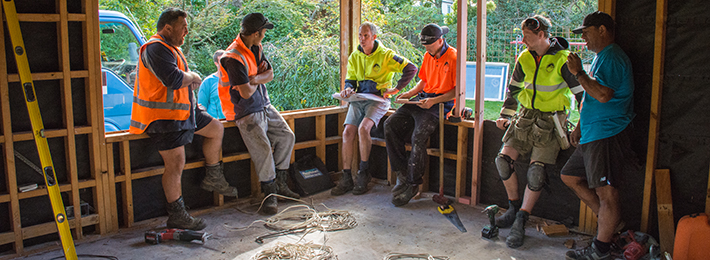Running a site induction
20 May 2016, Featured, Prove Your Know How, Safety

A business must provide information, training and instructions to protect workers and visitors on a construction site. Inductions are a great way to meet those requirements, but only when done properly
Inductions provide people with the basic knowledge of work health and safety requirements, such as the key risks they need to be aware of onsite and what to do in an emergency.
Anyone who has spent a period of time in the construction industry will know they can range from a handshake at the gate or signing your name at the bottom of a policy, through to spending half a day undertaking offsite training. We’ve put together the following guide to help ensure your inductions are up to scratch.
What information should be provided at a workplace induction?
Workplace inductions vary depending on the type of project and what stage it is at. For example, an induction to a single-storey house site could include a short pre-start meeting or on-the-job training.
For large and complex civil or commercial projects, a more detailed induction is required, including an explanation of the emergency response and evacuation processes. It’s good practice to let new workers and visitors to the site know about the following key points:
- Incident, emergency and evacuation procedures.
- The layout of the workplace, including entries and exits, location of facilities, first aid and security requirements.
- How to report incidents and hazards.
- Hazards and risks specific to the workplace.
- Control measures for those risks.
- Site-specific rules that must be complied with.
- Safety documents, policies and plans specific to the workplace.
Task specific training
If the person will be working on the site then you should give them task-specific training. This training provides information to people carrying out a particular job and what hazards, risks and control measures link to that particular task. This training should cover:
- Who is in charge and responsible.
- Information on the task an individual will be doing.
- Hazards, risks and control measures involved in carrying out the task.
- If relevant, it is good to show workers the Task Analysis/Safe Work Method Statement. Other documents such as standard operating procedures or work procedures are also a good idea.
- Any relevant legal responsibilities, codes of practice or technical standards that need to be followed.
How should an induction be carried out?
The way an induction is presented will depend on various factors, for example the number of people being inducted, the size of the workplace and the complexity of the health and safety matters to be discussed.
The method of delivering a workplace induction is up to the person in charge. It pays to consider any language or cultural barriers before deciding on
your induction process. Some ways induction training can be delivered are through:
- On-the-job training.
- Toolbox talk/pre-start meetings.
- Step-by-step checklists.
- Induction videos or booklets.
- Email or a phone conversation.
- Online interactive programmes.
Remember to keep a record
Where possible, a record should be kept of the names of people who have been inducted and trained. This should include the training content, who conducted the training and the date. Make sure the participant acknowledges the training; the best way to do this is to have them sign the training record.
Site Safe has a Site Specific Safety Plan on its website, which has many of the templates referred to in this article. Visit sitesafe.org.nz/sssp to download it for free.
Register to earn LBP Points Sign in



